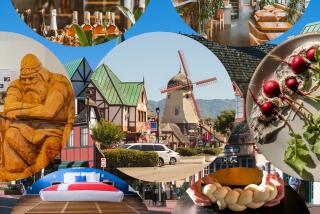The Sights of Summer in Beautiful Copenhagen
COPENHAGEN â As the Danish capital springs into summer with exuberance, youâre hard put to find a melancholy Dane.
Even Hamletâs spirits would be lifted during summer in Copenhagen.
As the days grow longer, trees turn green, flowers break through the soil and Copenhagenâs residents eagerly pour out-of-doors. Sun lovers head for parks. And even on the narrowest of streets (where the sun shines only briefly) locals linger on doorsteps to catch a few rays.
In addition to the sun, summer is brightened by events that would surprise poor Hamlet.
For one thing, Tivoli Gardens is open--perhaps the most anticipated occurrence of the season. When the turnstiles of the grand amusement park begin to turn (May through mid-September), no matter what the weather, summer is officially here.
Tivoli by Nigh
Tivoli during the day is one thing, but itâs late afternoon and evening (when 100,000 lights come on) that the park really comes to life. Crowds stream in for the concerts and to enjoy Tivoliâs cafes, music, dancing, jazz hall and fireworks, as well as the exciting rides and games of chance. Although there is an admission, much of the entertainment is free.
Summer also means Bakken is back. Built in 1583, it is believed to be the oldest amusement park in the world. Less sophisticated than Tivoli, it is more like an old-fashioned, down-to-earth fairground with beer halls, hot dog stands, restaurants, wandering minstrels, thrill rides and, curiously out of context, the A. L. Capone shooting gallery.
Thereâs also a lovely lake and a spring thatâs reputed to have curative powers, around which the park was developed.
Adjacent to Bakken, Klampenborg Deer Park occupies vast, tree-shaded grounds with a mini-palace, herds of fallow deer and loads of room to walk or picnic.
The old stable masterâs quarters have been converted into a restaurant (Peter Lieps Hus) named after the stable master. On a sunny day its patio is a popular place for a beer or lunch.
Bakken and Deer Park are in the town of Klampenborg a short train ride north of Copenhagen. From the station one can walk or take a horse-and-buggy ride to Bakken.
Sidewalk Cafes
Vying with Tivoli and Bakken as summer crowd attractions are Copenhagenâs sidewalk cafes. From the moment the weather turns warm the cafes draw visitors along sunny sidewalks and canals. If youâd care to join the Danes, head down the pedestrian shopping street (the Stroget) to where it ends at Kongers Nytorv, the largest square in Copenhagen and the site of the Royal Theater, along with an almost continuous stretch of colorful outdoor gathering places.
Nyhavn, once a favorite and frequently rowdy hangout for sailors, writers and artists, has become a trendy area of cafes, ice cream parlors, pizzerias, pubs and boutiques. From noon till late evening (summer days are long in these northern climes) the sidewalk cafes are crowded with Danes drinking beer and schnapps in the sun.
From the doors of the cafes to the edge of the canal itâs a sea of people. Pedestrians vie for space on the sidewalk with waiters and the spillover crowd. Along the canal, sailing ships are moored and boats are filled with tourists cruising by.
Nyhavn seems most popular with young people, although there are enough salt and pepper and gray heads to indicate that good food, service and a cheerful ambiance appeal to all ages. Especially recommended are Foergekro, Nyhavn 5, and Leonore Christine, Nyhavn No. 9.
The restaurants are housed on the lower floors of lovely old pastel-colored buildings with narrow wood-framed windows and steep-pitched roofs that, along with the canal, remind one of Holland. Theyâre often referred to as the âthree-steps-downâ cafes because theyâre below street level; when winter comes, the outdoor tables are abandoned and diners retreat downstairs to the warm interiors.
Gem of a Hotel
At the harbor end of Nyhavn is a gem of a small hotel called, simply, 71 Nyhavn.
The five-story building, with 82 rooms and six suites, is a remodeled old red-brick warehouse that has incorporated the huge beams and recessed windows of the original structure with Danish modern furnishings to create a warm and inviting retreat.
Many rooms overlook the canal or harbor and a changing panorama. It has a fine restaurant, the Pakhuskaelderen, and a cozy bar. All rooms have private bath, TV, mini-bar and phone, and run about $200 double.
In addition to being easy walking distance to the Stroget and the Royal Theater, itâs only a few blocks from the Amalienborg Palace.
Although prices are high in Denmark as in many European cities, there are ways to cut costs. Take advantage of the Copenhagen Card, available at main rail stations, hotels and travel bureaus. It allows free and unlimited travel by bus and rail in the city, including North East Sealand, free admission to many museums and sites, including Tivoli Gardens, and discounts on certain ferry crossings to Sweden.
The card costs about $12.50 U.S. for a day, $20 for two days and $30 for three days (half-price for children). Also check for restaurants featuring the Dan-Menu, where meals run about $12.50. A welcome plus: Tipping is normally included in the bill.
For more information on travel to Denmark, contact the Scandinavian National Tourist Offices, 655 3rd Ave., 18th Floor, New York 10017, (212) 949-2333.
More to Read
Sign up for The Wild
Weâll help you find the best places to hike, bike and run, as well as the perfect silent spots for meditation and yoga.
You may occasionally receive promotional content from the Los Angeles Times.






